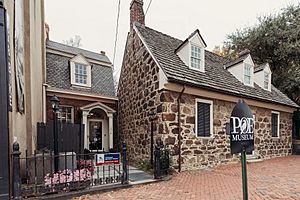Edgar Allan Poe Museum (Richmond, Virginia) facts for kids

Entrance to the museum in July 2020
|
|
| Established | 1922 |
|---|---|
| Location | 1914 E. Main St., Richmond, Virginia, U.S. |
| Type | Biographical museum |
|
Old Stone House
|
|
| Area | 0.4 acres (0.16 ha) |
| Built | 1750 |
| Architectural style | Colonial |
| NRHP reference No. | 73002222 |
| Significant dates | |
| Added to NRHP | November 14, 1973 |
The Poe Museum, also known as the Edgar Allan Poe Museum, is a special place in Richmond, Virginia, United States. It's a museum all about the famous American writer Edgar Allan Poe. Even though Poe never lived in the museum building itself, it celebrates the time he spent living and working in Richmond.
The museum has one of the biggest collections of Poe's original writings, letters, and personal items. It also shows what Richmond was like in the early 1800s when Poe lived there. The museum uses pictures, objects, and poems to tell the story of Poe's life and career, focusing on his many years in Richmond.
Contents
The Old Stone House
The Poe Museum is located in a building called the "Old Stone House." This house was built around 1740. It is thought to be the oldest original house still standing in Richmond. Jacob Ege, who came from Germany, built it as a home for his wife, Maria Dorothea Scheerer.
Scientists who study tree rings believe that more parts were added to the house in 1754. Jacob Ege passed away in 1762. His son, Samuel Ege, owned the house in 1782 when it first appeared on tax records. The Ege family owned the house until 1911.
Poe's Connection to the House
In 1824, a French hero named the Marquis de Lafayette visited Richmond. A group of young Richmonders, including 15-year-old Edgar Allan Poe, rode in a parade for Lafayette. Poe even stood as an honor guard outside the Ege house while Lafayette visited the people living there.
History of the Museum
Around 1909, which was 100 years after Poe's birth, some people in Richmond wanted to honor the writer more. They asked the city to build a statue of Poe. However, the city said no because they thought he was a "disreputable character."
This same group then decided to create the Poe Museum instead. The New York Times newspaper even wrote that 1909 was an important year for recognizing Poe. In 1911, a group called Preservation Virginia saved the Old Stone House. They opened it as the Poe Museum in 1922.
The museum is very close to where Poe lived in Richmond and where he worked at the Southern Literary Messenger newspaper. It's also near the grave of his mother, Eliza Poe, at St John's Church. Poe himself never lived in the museum building. The museum, first called the "Edgar Allan Poe Shrine," was finished on October 7, 1921.
Famous Visitors
Actor Vincent Price, who starred in many movies based on Poe's stories, was a big fan of the author. He visited the museum in 1975 and took a picture with the museum's famous stuffed raven.
In 2014, his daughter Victoria Price also visited the museum. She said that Poe had been such a big part of her life that she thought of him like an uncle. Victoria Price returned to Richmond in 2016 for a film festival that showed movies based on Poe's works.
What You Can See: Museum Exhibits
The Poe Museum has three buildings, and each one shows different parts of Edgar Allan Poe's life and what he left behind.
The Old Stone House Parlor
The main room of the Old Stone House displays furniture that belonged to Edgar Poe and his sister, Rosalie Mackenzie Poe. You can see a piano that was once his sister's and Edgar's childhood bed.
Elizabeth Arnold Poe Memorial Building
This building has many first and early copies of Poe's books. This includes a copy of "The Raven" from 1845. It also has one of only 12 known copies of Poe's first collection of poems, Tamerlane and Other Poems. You can also see original writings and old photographs called daguerreotypes here.
The North Building
The North Building explores the mystery surrounding Poe's death. Some interesting items on display include Poe's vest, his travel trunk, his walking stick, and even a lock of his hair. There are over 26 different ideas about how Poe died. The museum suggests that a practice from the 1800s called Cooping might have played a part in his death.
The Enchanted Garden
Behind the museum, there's a beautiful garden inspired by Poe's poem "To One in Paradise." This garden has a fountain, a special shrine, and different areas inspired by Poe's stories. For example, there's a rock with a character's name from "A Tale of the Ragged Mountains" carved into it. There's also a brick wall like the one described in "William Wilson."
The garden is also home to two black cats named Edgar and Pluto. They were found as stray kittens behind the museum and have lived there ever since. This lovely garden is also used for weddings.
Other Poe Sites
- Edgar Allan Poe House and Museum in Baltimore, Maryland
- Edgar Allan Poe National Historic Site in Philadelphia, Pennsylvania
- Edgar Allan Poe Cottage in The Bronx, New York

